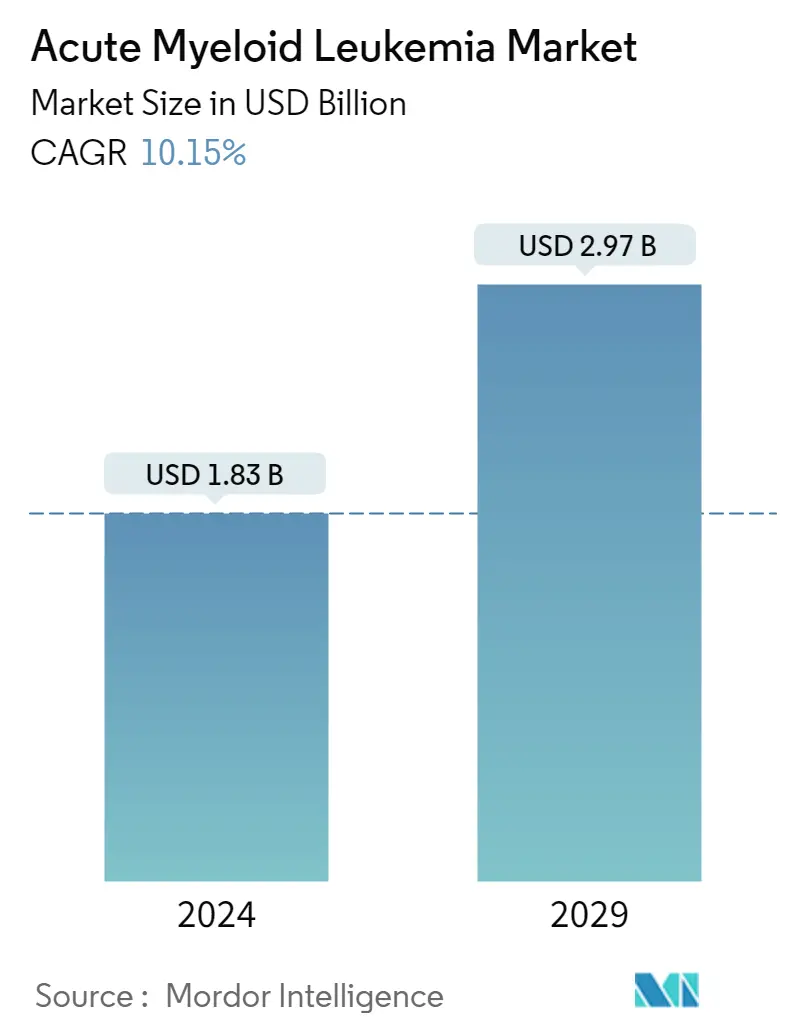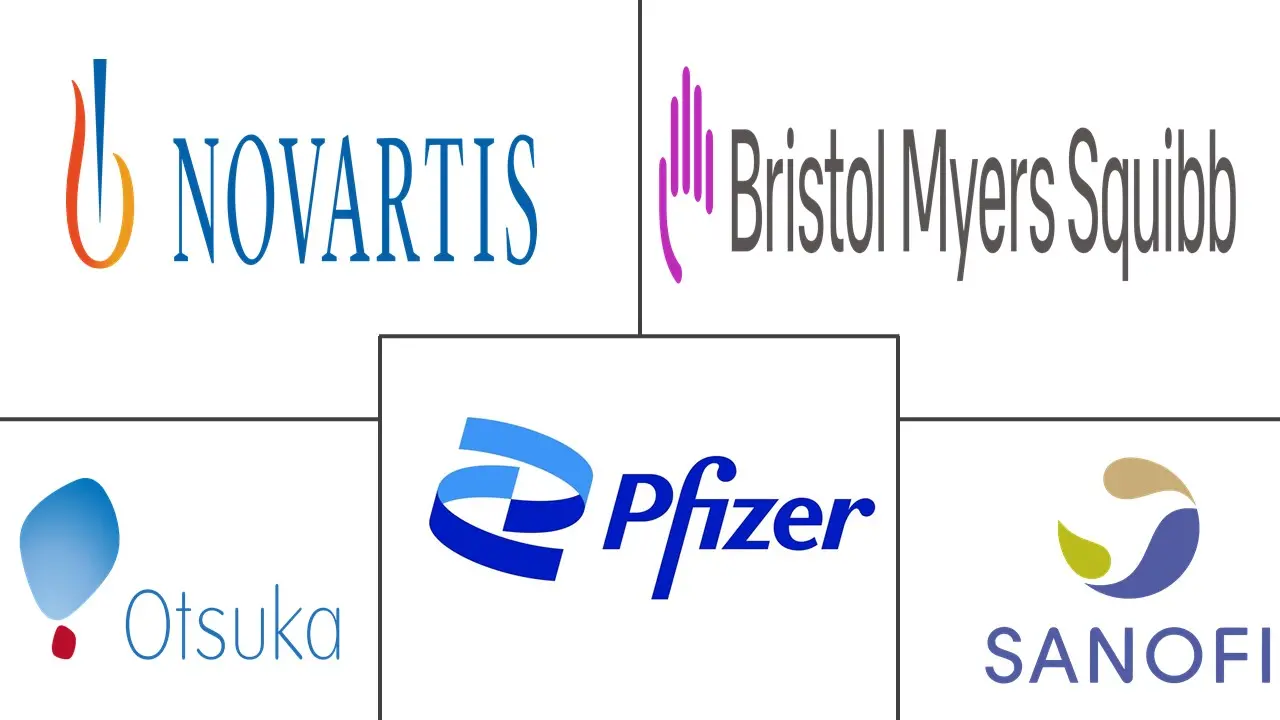Market Size of Acute Myeloid Leukemia Industry

| Study Period | 2021 - 2029 |
| Market Size (2024) | USD 1.83 Billion |
| Market Size (2029) | USD 2.97 Billion |
| CAGR (2024 - 2029) | 10.15 % |
| Fastest Growing Market | Asia Pacific |
| Largest Market | North America |
Major Players
*Disclaimer: Major Players sorted in no particular order |
Need a report that reflects how COVID-19 has impacted this market and its growth?
Acute Myeloid Leukemia Market Analysis
The Acute Myeloid Leukemia Market size is estimated at USD 1.83 billion in 2024, and is expected to reach USD 2.97 billion by 2029, growing at a CAGR of 10.15% during the forecast period (2024-2029).
The COVID-19 pandemic has significantly impacted the acute myeloid leukemia market. Cancer treatments such as chemotherapy and immune suppressants damage the patient's immune system. This weakened immune system of the target population is expected to create a risk of Covid-19 infection. Various research was conducted to find the impact of Covid 19 on AML patients. According to the National Cancer Institute (NCI), in August 2021, people with cancer had a higher risk of severe illness from COVID-19.
Furthermore, according to an article published by the American Society of Hematology, in January 2022, due to anticipated shortfalls in blood bank supplies during the COVID-19 pandemic, blood transfusion thresholds were lowered while taking into account significant local/regional variability. Patients who tested positive for COVID-19 had got their treatment delayed. Since newly discovered AML is a treatment-emergent, intensive induction chemotherapy was made available to eligible AML patients. Thus, increased risk for an AML in a pandemic and the shortage of other treatment modalities are expected to drive the demand for AML drugs.
The key factors propelling the growth of this market are the high incidence and prevalence of acute myeloid leukemia, advancements in pharmacology and molecular biology to promote drug development, and increasing investments in research and development by pharmaceutical companies. According to the American Cancer Society, it is estimated that there will be 60,650 new leukemia cancer cases, of which 24,000 are expected to die in 2022 in the US. In addition, according to the same source, 20,050 new cases of acute myeloid leukemia (AML) are estimated in 2022 in the US. It will lead to increased adoption of AML therapies. The rising prevalence of AML in developed countries such as the US is expected to drive this market's growth.
Furthermore, with the rising investment in research and development, there is an increasing number of clinical trials conducted to demonstrate the effectiveness of the drugs. It is expected to drive the market over the forecast period. For Instance, according to the United States National Library of Medicine, a study titled 'Daunorubicin or Idarubicin With Cytarabine Plus Quizartinib vs. Physician's Choice in Newly Diagnosed FLT3-ITD+ AML (Q-SOC)' is in Phase III of clinical trials. The study was estimated to start in November 2021 and be complete in March 2025.
Thus, the abovementioned factors are impacting the market growth of the Acute myeloid leukemia market. However, stringent regulations on drugs and complications related to chemotherapy are the factors expected to restrain the market growth.
Acute Myeloid Leukemia Industry Segmentation
As per the scope of this report, acute myeloid leukemia is also known as acute myelogenous leukemia, acute myeloblastic leukemia, acute granulocytic leukemia, or acute non-lymphocytic leukemia. In acute myeloid leukemia, abnormal white blood cells are rapidly collected in the bone marrow and disturb the production of normal blood cells.
The Acute Myeloid Leukemia Market is segmented by chemotherapy (Cytarabine, Anthracycline Drugs, Alkylating Agents, Anti-metabolites, Tyrosine Kinase Inhibitors, hormonal therapy, and other chemotherapies) and geography (North America, Europe, Asia-Pacific, Middle East & Africa, and South America). The report also covers the estimated market sizes and trends for 17 countries across major global regions. The report offers the value in (USD million) for the above segments.
| Chemotherapy | |
| Cytarabine | |
| Anthracycline Drugs | |
| Alkylating Agents | |
| Anti-metabolites | |
| Tyrosine Kinase Inhibitors | |
| Hormonal Therapy | |
| Other Chemotherapies |
| Geography | ||||||||
| ||||||||
| ||||||||
| ||||||||
| ||||||||
|
Acute Myeloid Leukemia Market Size Summary
The acute myeloid leukemia (AML) market is poised for significant growth over the forecast period, driven by a combination of high incidence rates, advancements in drug development, and increased research investments. The market is experiencing a surge in demand for AML therapies due to the rising prevalence of the disease, particularly in developed regions like North America. The COVID-19 pandemic has further influenced the market dynamics, as it highlighted the vulnerabilities of AML patients and led to delays in treatment, thereby increasing the need for effective AML drugs. The market is characterized by a consolidated landscape with key players such as Novartis AG, Teva Pharmaceuticals, and Pfizer, who are actively involved in developing and marketing AML therapies.
Cytarabine, a critical drug in the chemotherapy segment, is expected to maintain a significant market share due to its effectiveness in treating AML and the rising approvals from regulatory authorities like the US Food and Drug Administration. The market's growth is also supported by ongoing clinical trials and the introduction of new treatment modalities. North America remains a dominant region, with the US leading in AML cases, which drives the adoption of therapies. The competitive landscape is marked by strategic collaborations and product launches, further propelling market expansion. Despite challenges such as stringent regulations and chemotherapy complications, the AML market is set to grow robustly, supported by continuous innovation and regulatory support.
Acute Myeloid Leukemia Market Size - Table of Contents
-
1. MARKET DYNAMICS
-
1.1 Market Overview
-
1.2 Market Drivers
-
1.2.1 High Incidence and Prevalence of Acute Myeloid Leukemia
-
1.2.2 Advancement in Pharmacology and Molecular Biology to Promote Drug Development
-
1.2.3 Increasing Investments in Research and Development
-
-
1.3 Market Restraints
-
1.3.1 Stringent Regulations on Drugs
-
1.3.2 Complications Related to Chemotherapy
-
-
1.4 Porter's Five Forces Analysis
-
1.4.1 Bargaining Power of Suppliers
-
1.4.2 Bargaining Power of Buyers/Consumers
-
1.4.3 Threat of New Entrants
-
1.4.4 Threat of Substitute Products
-
1.4.5 Intensity of Competitive Rivalry
-
-
-
2. MARKET SEGMENTATION (Market Size by Value - USD million)
-
2.1 Chemotherapy
-
2.1.1 Cytarabine
-
2.1.2 Anthracycline Drugs
-
2.1.3 Alkylating Agents
-
2.1.4 Anti-metabolites
-
2.1.5 Tyrosine Kinase Inhibitors
-
2.1.6 Hormonal Therapy
-
2.1.7 Other Chemotherapies
-
-
2.2 Geography
-
2.2.1 North America
-
2.2.1.1 United States
-
2.2.1.2 Canada
-
2.2.1.3 Mexico
-
-
2.2.2 Europe
-
2.2.2.1 Germany
-
2.2.2.2 United Kingdom
-
2.2.2.3 France
-
2.2.2.4 Italy
-
2.2.2.5 Spain
-
2.2.2.6 Rest of Europe
-
-
2.2.3 Asia-Pacific
-
2.2.3.1 China
-
2.2.3.2 Japan
-
2.2.3.3 India
-
2.2.3.4 Australia
-
2.2.3.5 South Korea
-
2.2.3.6 Rest of Asia-Pacific
-
-
2.2.4 Middle East & Africa
-
2.2.4.1 GCC
-
2.2.4.2 South Africa
-
2.2.4.3 Rest of Middle East & Africa
-
-
2.2.5 South America
-
2.2.5.1 Brazil
-
2.2.5.2 Argentina
-
2.2.5.3 Rest of South America
-
-
-
Acute Myeloid Leukemia Market Size FAQs
How big is the Acute Myeloid Leukemia Market?
The Acute Myeloid Leukemia Market size is expected to reach USD 1.83 billion in 2024 and grow at a CAGR of 10.15% to reach USD 2.97 billion by 2029.
What is the current Acute Myeloid Leukemia Market size?
In 2024, the Acute Myeloid Leukemia Market size is expected to reach USD 1.83 billion.

